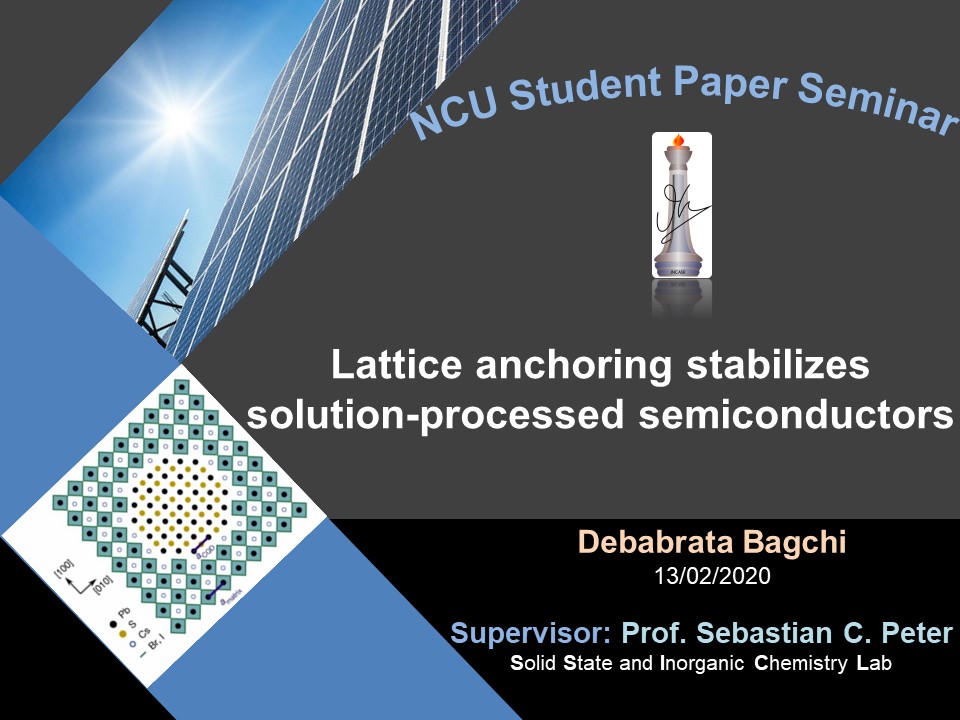Lattice anchoring stabilizes the solution processes semiconducts - PowerPoint PPT Presentation
Title:
Lattice anchoring stabilizes the solution processes semiconducts
Description:
Lattice anchoring between colloidal crystal and perovskite semiconductor stabilizes can be a useful strategy for a stable semiconductor interface for solar cell application – PowerPoint PPT presentation
Number of Views:0
Title: Lattice anchoring stabilizes the solution processes semiconducts
1
(No Transcript)
2
Nature 2019, 570, 96-101
https//doi.org/10.1038/s41586-019-1239-7
Mengxia Liu1, Yuelang Chen2, Chih-Shan tan1,
Rafael Quintero-Bermudez1, Andrew H. Proppe1,2,
Rahim Munir3,4, Hairen Tan1,5, Oleksandr Voznyy1,
Benjamin Scheffel1, Grant Walters1, Andrew Pak
tao Kam1, Bin Sun1, Min-Jae Choi1, Sjoerd
Hoogland1, Aram Amassian3,6, Shana O. Kelley2,7,
F. Pelayo García de Arquer1 Edward H. Sargent1
Edward H. Sargent
Shana O. Kelley
Aram Amassian
6
5
1,2
4
3
2
3
Outline
3
4
Solution-processed semiconductors
Solution-processed semiconductors are the class
of photoactive materials that can be processed in
ink form through wet chemistry
Solution phase synthesis
García de Arquer, F. P. et al. Nat. Rev. Mater.
2017, 2, 16100.
5
Where to use?
Light Sensing
Photovoltaic Solar Cell
Light Emitting Diode
García de Arquer, F. P. et al. Nat. Rev. Mater.
2017, 2, 16100.
6
Instability of Perovskite materials
Organic-inorganic halide perovskites
Power conversion efficiency (PCE) 27.3
- ABX3, where A CH3NH3 (MA) or
- HC(NH2)2 (FA) B Pb2 X halides
Ju. M. G. et al. Joule 2018, 2, 1231-1241.
Liu. C. et al. NPG Asia Mat. 2018, 10, 552-561.
7
Novelty of the Paper
Perovskite
Colloidal Quantum Dot
O2
O2
O2
O2
PbS-CQD
8
Epitaxial alignment between CsPbX3 and CQDs
- Atomistic model of a CQDperovskite
- lattice-anchored hybrid materials system
- The lattice constant of CQDs and perovskites of
different stoichiometry
By tuning the ratio of Br to I near-zero lattice
mismatch (e) for PbS CQDs at a Br 66 (e lt 0.2),
enabling the strain-free epitaxial growth of
perovskite.
Beal, R. E. et al. J. Phys. Chem. Lett. 2016, 7,
746-751.
9
CQD synthesis and ligand exchange
10
Surface engineering of CQD
11
Incorporation of perovskite into CQD
vortexed for 3 min to transfer CQD to DMF
11 volume ratio
Perovskite Precursor
- Film fabrication
Thermal annealing 100 C for 10 min
Substrate
2000 r.p.m. for 60 s
Multijunction solar cell
- The amount of perovskite matrix, and thus the
average dot-to-dot distance, is tuned through the
ratio of CQD to perovskite.
12
X-ray diffraction study
v
XRD was conducted at the 6-ID-D beamline at
Argonne National Laboratory, USA.
13
Transmission Electron Microscopy
PbS-CsPbBrI2 matrix
PbS-CsPbBr2I matrix
- The shell has a lower contrast compared with the
CQDs, as the perovskite has a lower density than
PbS - As the amount of perovskite increases, the shell
grows thicker forms a continuous matrix with
dots - No spacing differences between core CQD and
perovskite shell were observed, indicating
epitaxial orientational alignment at two dominant
facets.
14
TEM Images and Colour Mapping
- PbS quantum dots with a thin CsPbBrI2 perovskite
shell
- PbS quantum dots in CsPbBrI2 matrix structure
- At higher concentration of CsPbBrI2, perovskite
makes continuous matrix with PbS CQD embedded in
it.
15
Elemental analysis of PbSCsPbBr2I hybrid films
33 vol CQD
10 vol CQD
20 vol CQD
Pb
Pb
- Elemental mapping from energy dispersive X-ray
spectroscopy (EDX) in scanning electron
microscopy indicates a uniform elemental
distribution in the hybrid films
16
Stability of CQD-anchored CsPbX3 perovskites
17
Morphology of CQDPerovskite hybrid films
SEM images of CsPbBr2I
CsPbBr2I
CsPbBrI2
18
Effect of temperature on Packing Density
At 70 C
GIAXS was conducted at the D1 beamline, Cornell
High Energy Synchrotron Source (CHESS).
19
Photoluminescence (PL) studies
- Matrix-protected films maintain 90 of the
initial value after annealing whereas pure CQD
film shows a rapid PL quenching and loses half of
the intensity after an hour
Theoretical volume fraction 64
- 30 of film volume occupied by high-barrier
vacuum perovskite matrix can fill these voids
substantially, this could ease transport by
lowering the barrier
20
Transient absorption spectroscopy
- Doubling in carrier mobility in the
matrix-protected CQDs with 15 vol CsPbBr2I
compared with pristine CQD films
21
Photoluminescence (PL) studies
- PL signal from perovskite is completely quenched,
showing an efficient carrier transfer from the
matrix to the CQDs - Photocarriers transfer from the matrix to the
CQDs contributes to an enhanced near-infrared PL
emission - Lattice matched system shows maximum PLQE at
infrared wavelength.
22
Stability studies of CQDPerovskite hybrid films
Control Study
23
Solar Cell Application
Device architecture
Liu, M. et al. Nat. Mat. 2017, 16, 258-263.
24
Conclusion Future aspects
Lattice-anchoring strategy provides
solution-processed semiconductor materials with
increased stability relative to either
constituent phase
Incorporating PbS CQDs into CsPbBrxI3-x
perovskites suppressed the formation of the
undesired d-phase configuration
Increased the lifetime of a-phase Caesium lead
halide perovskite, including multi-hour thermal
stability at 200 C
The epitaxially oriented perovskite matrix
provides excellent stabilisation to CQD surfaces,
inhibiting attack from oxygen at elevated
temperatures
Perovskite matrix lowers the energetic barrier
to carrier transport, contributing to a doubling
in carrier mobility
Perovskite-CQD hybrid shows enhanced solar cell
performance and long term stability compared to
pristine materials.
25
(No Transcript)































